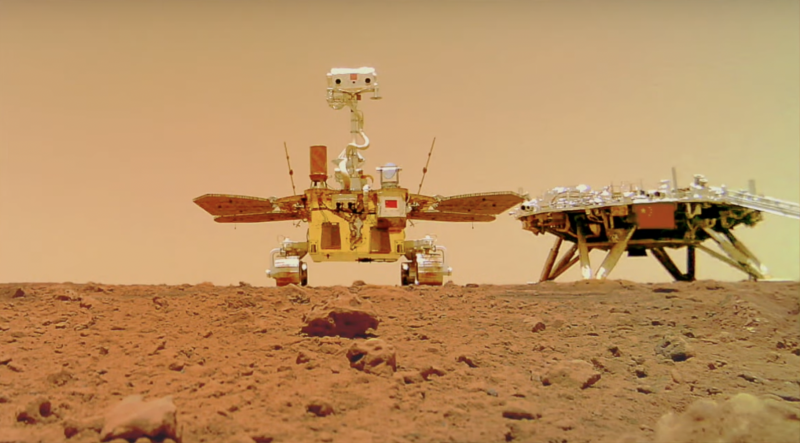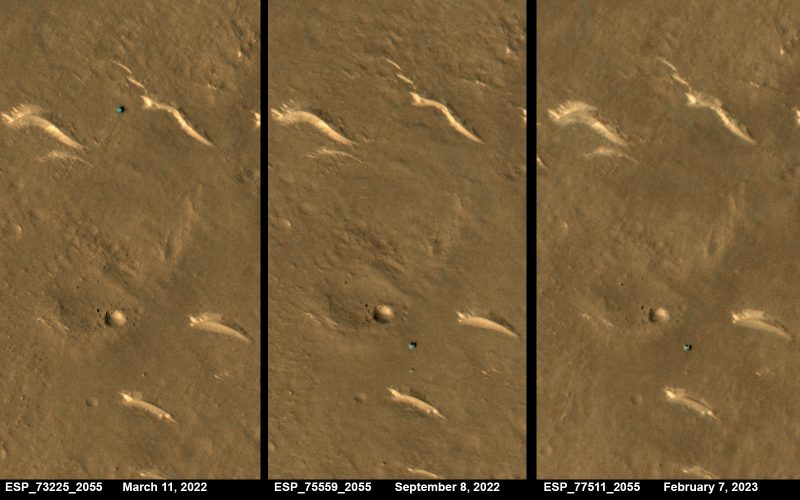
Chinese Mars rover no longer moving
The Chinese Mars rover Zhurong appears not to have moved for about six months. Has its mission ended? There’s been no official word about the rover from CNSA – the Chinese space agency – since May of 2022. That’s when the rover entered a dormant state in anticipation of a long, cold and dusty Martian winter.
News of the rover’s apparent demise comes not from the Chinese space agency that launched it, but from scientists operating NASA’s Mars Reconnaissance Orbiter. A series of three images from the HiRISE camera – which looks down on Mars’ surface from above – confirms that the rover was still on the move between March 11 and September 8, 2022.
But a third image – taken this month, on February 7, 2023 – shows the Zhurong rover hasn’t moved since September. That’s despite the fact that CNSA indicated it would be back in action at the end of 2022.
NASA scientists released the images on February 21. See them below.

Last chance to get a moon phase calendar! Only a few left. On sale now.
Rover tracks reveal Mars’ secrets
The Lunar and Planetary Laboratory at the University of Arizona released a composite of three images taken by the HiRISE (High Resolution Imagery Science Experiment) as it sailed over the surface of the red planet aboard the Mars Reconnaissance Orbiter.
The University of Arizona oversees the Mars Reconnaissance Orbiter, in conjunction with the Jet Propulsion Laboratory at CalTech and NASA. Researchers there acquired the images because, as they said, the way rovers and other craft disturb Mars’ surface provides important data:
HiRISE is often used to observe changes to dust-covered areas near Mars surface missions. The blast zones around landings or tracks left by rovers can help scientists infer what the properties of surface materials are like.
The composite image from HiRISE was released Tuesday (February 21, 2023). HiRISE’s overseers said that the camera’s imagery is the most detailed ever captured of another planet, with each pixel representing about 12 inches (30 cm).
Chinese rover on Mars
After a 202-day journey, the China National Space Agency’s (CNSA) Tianwen-1 mission to Mars entered orbit on February 10, 2021. The probe produced stunning video of its arrival:
So, here's quite a amazing video of Tianwen-1 passing Mars as it enters orbit (CNSA/PEC) pic.twitter.com/nUbzhizi0O
— Andrew Jones (@AJ_FI) February 12, 2021
The Zhurong rover touched down three months later in May at Utopia Planitia, an extensive open plain in Mars’ northern hemisphere that may have been caused by a large impact. The rover gathered topographical, geological, soil, mineral and rock data at least until a planned power-down a year later on May 18, 2022.
The last official word about the Zhurong rover from CNSA was:
In response to the reduced power generation capacity of the solar wings caused by sand and dust weather and the extremely low ambient temperature in winter, according to the design plan and flight control strategy, the Mars rover entered sleep mode on May 18. It is expected that around December this year, the ‘Zhurong’ inspection area will enter the early spring season, and normal work will resume after the environmental conditions improve.
But the rover’s work has not resumed, at least not so far.
It’s worth noting that winter on Mars is extreme. The area the Zhurong rover had been inspecting experienced daytime highs in winter of -4 F (-20 C) and lows ranging down to -148 F (-100 C) at night. Additionally, the CNSA said the area also suffered a dust storm in March and April 2022, just before the power-down.
Dust covering the rover’s solar power panels is the likely culprit in the apparent end-of-mission, if that’s indeed what’s happening.
Bottom line: The Chinese Mars rover Zhurong has not moved since at least September 2022.











